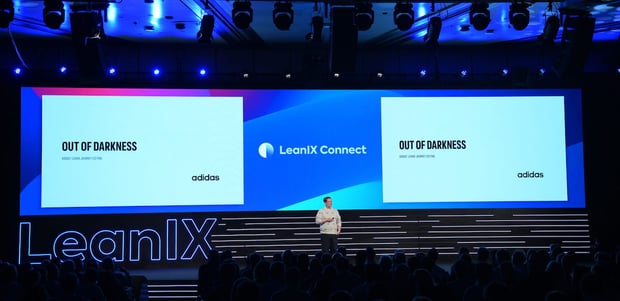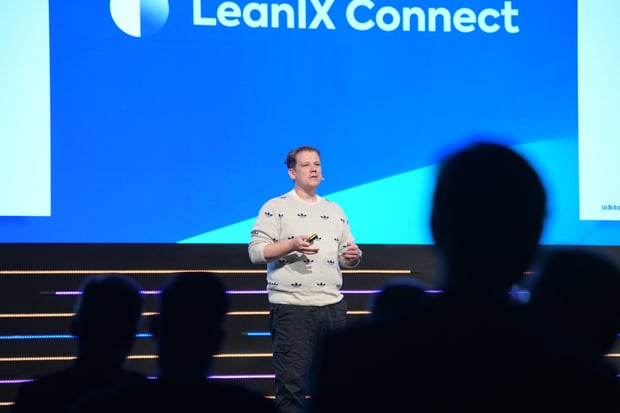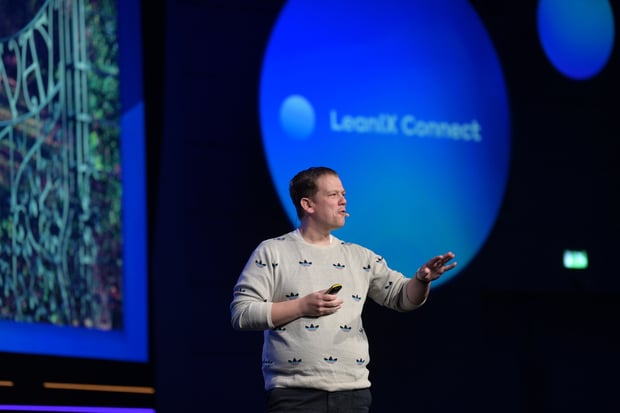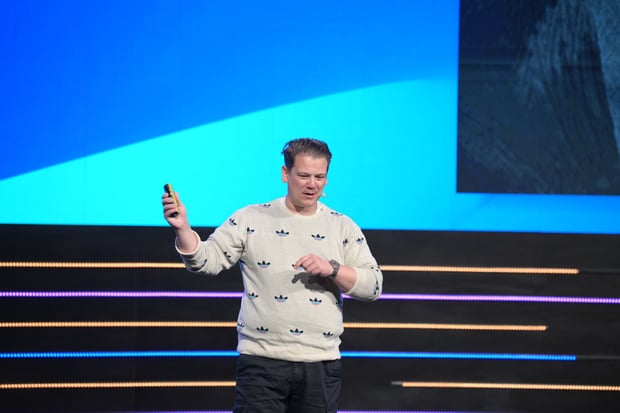
Adidas VP of Enterprise Architecture, Daniel Eichten, recently spoke at the LeanIX Connect summit Europe 2023. Discover how adidas leveraged the LeanIX Enterprise Architecture Management (EAM) platform to streamline its IT landscape.
Adidas was the first company to take the stage following our CEO, André Christ's opening keynote at the LeanIX Connect summit Europe 2023. Daniel Eicten, adidas VP of Enterprise Architecture, took us through adidas' journey from legacy IT to an optimized enterprise architecture model.
André set the stage for us by summarizing what's on the minds of enterprise architects in 2023, as well as some of the initiatives we're leading to help them deal with those issues. During the talk, he invited Daniel Eichten from adidas on stage to discuss the crucial issue of open-source software security.
Daniel explained that the Apache log4j 2 vulnerability that was identified in December 2021 was a wake up call for adidas on open-source software security. What was a nightmare at the time, Daniel told us, is now manageable using the LeanIX Value Stream Management (VSM) tool, which the company is already running in the sales domain and plans to expand the use of soon.
To find out more about using the LeanIX VSM to manage your open-source software security risk, read:
How Our VSM Tool Overcame The PyTorch Supply Chain Attack
Shortly after helping André out with his keynote, Daniel took the stage for his own presentation. He explained how, along with our VSM, adidas is using the LeanIX Enterprise Architecture Management (EAM) tool to make sense of its IT landscape.
LeanIX: Bringing Light Out Of Darkness For adidas

Daniel opened his talk with a retelling of the Christian creation myth as a metaphor for enterprise architecture management (EAM). This grand metaphor served to explain the journey adidas has gone on with LeanIX.
In the creation myth, we begin with darkness. Then, there was light, and the light was separated from the darkness by day and night.
Then land was separated from the water, and both were populated with plants and animals. This, Daniel explained, is very like what you do with enterprise architecture management.
You start without really knowing what's going on with your IT landscape or what it contains. You use the LeanIX EAM to turn on the lights and find clarity in your landscape, then you separate, categorize, and populate.
Of course, adidas was not completely in the dark about their IT landscape before they used LeanIX, but it was close. Daniel compares it to the light of a candle, rather than the light of the sun, where they exist now.
Adidas had an EAM tool at the time, but it was only accessible to a small number of people in the business, and most employees weren't even aware of it. This meant that adidas' enterprise architects were left stumbling around in the dark with only a small area of light to work with.
That's when the decision was made to move to LeanIX. The biggest step in the transition was opening up the LeanIX platform to all 60,000 employees.
Shining The Light: LeanIX For All adidas Employees

Daniel asked us all to imagine how intimidating it was to give access to the LeanIX Enterprise Architecture Management (EAM) platform to all 60,000 employees. At first, they didn't even have user roles and everyone had full write capabilities.
Of course, things have changed. Now, adidas has utilized the admin roles built into the LeanIX EAM to protect their data, but this wasn't the initial case.
Given the circumstances, the data that was fed into our EAM at the time wasn't always accurate. Yet, for the first time, adidas had a complete map of their application portfolio to work with.
This brought light to all manner of unknown applications across their IT landscape. From regional payroll systems, to localized warehouse systems, LeanIX brought decentralized systems from across their IT landscape into the light.
The next step was to start to rationalize those applications and set up a process whereby heterogenous market segments could consult their enterprise architects on best practice. Standards were also created so that consultation was only necessary when there was a doubt about whether software was desirable or not.
At the time, this was still a manual process, but it was a vast improvement on the situation before, where there was no process at all. Once the application portfolio was under control, Daniel next turned to projects.
Focusing The Light: Enterprise Architecture Product Support

Once adidas had brought its application portfolio in line through the LeanIX Enterprise Architecture Management (EAM) platform, it needed governance of its projects. Daniel explained that the process began with a series of pitches from project managers for the support they needed.
This allowed Daniel's team to assess the project impact on the application portfolio map within the LeanIX EAM. It also enabled them to scope for technology requirements and cost out resources for each project.
Best of all, Daniel explained, this allowed them to fully document all the decisions they made and the reasons for these. This not only made decision-making transparent, but also set a benchmark for future approvals.
This was even more useful when adidas decided to move to a product-led structure. The product domain map was already tracked through LeanIX, so it was easy to re-organize under those criteria.
As time went on, Daniel's team implemented LeanIX into additional processes, such as server deployments, new cloud subscriptions, and procurement processes. This served to both keep the LeanIX map updated, but also prevented "zombie" systems from operating without restriction.
"Zombie", of course, has long been a term used to describe outdated applications that continue to survive long after they have expired and begun to break down. Yet, you can't treat zombie systems the way characters treat actual zombies in movies.
Zombie systems are often closely tied to your enterprise architecture and disposing of them is more like a surgical procedure than a shotgun blast to the head. LeanIX empowers adidas to understand where zombie systems connect to the rest of the IT landscape and remove them safely without risk.
Let The Light Shine: Enterprise Architecture Automation
As Daniel had explained, the initial enterprise architecture process was manual. Yet, the next stage of adidas' enterprise architecture management (EAM) process was to create a ticketing process for procurement.
Now, when an employee wants to onboard a new piece of software, they raise a ticket and tasks are automatically generated for enterprise architecture, IT security, data privacy, and other departments to review the application. Once again, this also includes a decision log, documenting why applications have been approved or denied.
Automation has also notified enterprise architects and application owners about hundreds of end-of-life zombie applications. The LeanIX EAM has then given clarity on where and how those systems are interconnected to the IT landscape, so they can be removed.
The key to this automation is integration. LeanIX is not a swiss army knife, but a specialized implement that works effectively with the rest of your enterprise architecture toolset.
Daniel was particularly excited to hear about our integration with Collibra, announced at Connect 2023. Adidas already use Collibra and Daniel anticipates adding data intelligence tools to their LeanIX platform.
To find out more about the Leanix and Collibra integration, read:
LeanIX Platform Powers Up Data Governance With Collibra
What's Next For adidas And LeanIX?
To wrap up his talk, Daniel gave a summary of adidas' plans for developing its enterprise architecture management (EAM) function further using LeanIX. First up, Daniel is looking to update the company's meta model to ensure the whole organization has a better understanding of it.
This is fortunate, as André announced our updated meta model functionality in his keynote just before Daniel took the stage. To find out more, read:
Connect 2023: 3 Innovations Coming To The LeanIX Platform
Daniel also explained that adidas is currently looking at an identity governance and administration tool (IGA) that will notify their enterprise architects when an application owner leaves the company or is replaced in the role. Not to mention, they're also looking at enhanced data gathering for requests for proposal (RFP).
To end his talk, Daniel mirrored André in mentioning the key topic of sustainability within IT. A goal of Daniel's is to get information about how environmentally friendly each application adidas uses is into the LeanIX EAM.
We were thrilled to hear this recap of our success working with adidas, and also to look forward to future projects together. To revisit Daniel's talk along with the many other video on-demand presentations from the LeanIX Connect summit Europe 2023, register for free:
.png?width=140&height=107&name=BTMPlaybook-FI%20(1).png)

